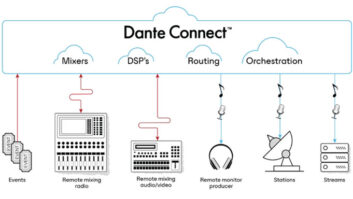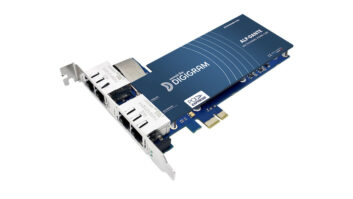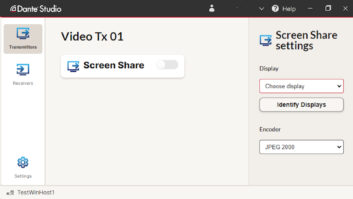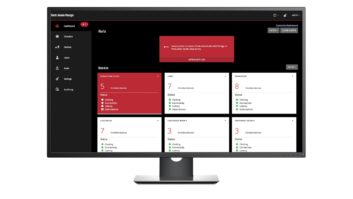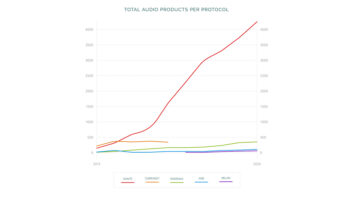
With live sound, post production and, increasingly, music production facilities now routinely utilizing audio-over-IP networks, 2018 looks like it could be the year that the broadcast world also reaches the proverbial tipping point and joins them. As the recent NAB Show demonstrated, several foundational standards have now fallen into place, instilling much-needed confidence throughout the industry, while the introduction of new audio products that don’t incorporate some form of networking has become a rarity.
Key to the proliferation of networking throughout the pro audio business is the AES67 high-performance streaming audio-over-IP interoperability standard, which has come to provide the common thread—the one ring to rule them all, if you will—between the many and various networking schemes available. For example, AES67 has been adopted for audio transport by the SMPTE ST 2110 suite of standards for professional media over managed IP networks, critical to the broadcast industry, which is well on its way to being published in full. Additionally, a growing number of manufacturers that have developed proprietary AoIP networks—such as ALC NetworX’s Ravenna, Audinate’s Dante, Calrec’s Hydra2, Telos Alliance’s Livewire+ AES67 and Wheatstone’s WheatNet—now offer compliance, while typically also providing the discovery and control features intentionally not included in the AES67 standard.
Yet the publication of a standard such as AES67 is only the start of the process. Initially published in September 2013, AES67 was released with an addendum in 2014, was revised in 2015 and, on April 15, 2018, was revised yet again.
AES67-2018 includes certain clarifications and minor corrections, but most importantly, it adds a Protocol Implementation Conformance Statement, or PICS, as an Annex. As the notification from the Audio Engineering Society states, PICS “is a valuable tool to ensure proper compliance of AES67 implementations.” An AES67 implementation conforming to the published standard must complete a PICS proforma that states which protocol capabilities and options have been implemented.
The PICS serves a variety of purposes. For instance, it can act as a checklist by the protocol implementer to reduce the risk of failure to conform to the standard through oversight, the AES statement notes. Alternately, it may serve as a detailed indication of the capabilities of the implementation relative to what is understood to be included in the standard PICS proforma. Lastly, it can be used to check potential interoperation with other AES67-compatible implementations. As the AES notes, “While interworking can never be guaranteed, failure to interwork can often be predicted from incompatible PICS.”
The AES has also established a task group, SC-02-12-R, to define a standardized method for transporting metadata associated with audio in parallel to, rather than part of, the AES67 stream. As part of the published scope of work, the AES is suggesting that the task group consider “an open, standards-based framework that supports both static and dynamic, time-synchronous metadata that is optimized for live workflow applications.”
Standards work requires funding, of course, and the AES has just acknowledged the support of three manufacturers in its AES Standards Sustainer program. Waves has joined at the Silver level, as has PreSonus, and Attero Tech has joined at the basic level.
In mid-April, the AES also announced that, in response to requests from manufacturers implementing the standard, it has introduced an AES67 logo for use on goods and literature to identify products that conform to the specification. “Manufacturers must verify that their product conforms to the requirements of the standard before affixing the logo to their product, its literature or their advertising,” according to the announcement. It promises that further details of the logo and its license terms are forthcoming.
With interoperability the name of the networking game, Audio Video Bridging/Time Sensitive Networking or AVB/TSN is still something of an outlier. Developed by the Institute of Electrical and Electronics Engineers (IEEE), which originally standardized Ethernet back in the day, AVB/TSN is a Layer 2 open standards protocol and therefore essentially incompatible with AES67, which is a Layer 3 protocol. Nevertheless, AVB/TSN been adopted by various pro audio manufacturers, most notably Biamp Systems. But as Biamp’s product marketing manager John Urban noted about a year ago, “AVB/TSN remains on the Slope of Enlightenment in Gartner’s Hype Cycle methodology”—that is, while increasingly better understood, it is not yet widely implemented—and added that “it’s simply a matter of time until AVB/TSN reaches a status of ubiquity in network design and usage.”
Calrec Audio went some way to bridging the gap between AES67 and AVB/TSN with the introduction of a series of interfaces supporting AES67/Ravenna, Dante with AES67 compatibility, AVB and ST 2022-6 video. “Customers can now interface with multiple protocols at the same time. For example, a signal can be received via AES67 and then sent out via SMPTE 2022, AVB, Ravenna, Dante or AES67,” according to Dave Letson, Calrec’s vice president of sales.
Prior to broader adoption of AES67, Audinate perhaps did more to promote AoIP networking than any other organization. According to the latest announcement from the company, there are more than 1,400 commercially available products supporting Dante from 400-plus AV manufacturers.
In May, the company announced that more than 400 Dante-enabled products from various AV manufacturers now feature upgraded firmware supporting Dante Domain Manager, which adds such features as user authentication, role-based security and audit capabilities to its scalability and organization of Dante systems over a network topology.
Audinate introduced AES67 support in 2017 in its Dante Brooklyn II, Dante Broadway, Dante PCIe, Dante MY-16, Dante HC and Dante IP Core products. In April of this year, the company announced plans to support SMPTE ST 2110 in the Dante platform by the end of 2018.
Not that there haven’t been other advocates for AoIP networking. The Media Networking Alliance (MNA), which has long promoted the AES67 cause, merged its membership with the Alliance for IP Media Solutions late last year under the AIMS brand. Following the 2018 NAB Show, at which AIMS promoted IP interoperability at the IP Showcase alongside other world trade associations, the organization announced that membership has further increased since the merger to 96 with the addition of ALC NetworX, the BBC, Focusrite, Merging Technologies and Yamaha, among others.
“Like AIMS, MNA members were committed to adopting a standards-based approach to interoperability. In their case, it was interoperability between various IP-based audio networks via the use of AES67, and they made tremendous strides toward that goal,” said Michael Cronk, AIMS chairman of the board. “By merging with AIMS, these companies are having even broader impact on the industries they serve—and they’re a driving force behind true industry-wide AV IP interoperability across the broadcast, installed systems and live sound markets.”

